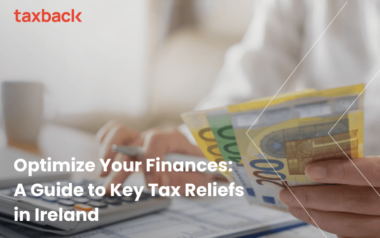Want to stay fit, help the environment and save money? Ireland’s Cycle to Work scheme will help you do just that!
Does your employer offer you the opportunity to avail of the Cycle to Work scheme?
Great! Not only is it good for your health and the environment, your wallet will reap the rewards too.

How does the Cycle to Work scheme work?
The Cycle to Work scheme allows employers to purchase new bikes and bicycle safety equipment for their employees. These items are not a taxable benefit-in-kind (BIK) like say, a gym membership or a gift card. Read more about paying tax on your BIK gym membership here.
Of course, like any work related benefits, there are some rules that apply to employers and employees if they wish to partake in this scheme.
These rules are as follows:
- Items that are purchased under the scheme must be made available to all employees and directors.
- The items must be used for ‘qualifying journeys’ aka, your morning commute (or part of it at least).
- For pedelecs or ebikes and related safety equipment the limit is €1,500. For other bicycles and related safety equipment the limit is now €1,250.
- It must be purchased by the employer. If an employee is reimbursed, there is no tax exemption.
- You can only avail of the Cycle to Work Scheme every four years. The tax year in which the bicycle is purchased counts as the first year. For instance, if you used the scheme at any time during the year 2016, you can’t claim it again until 2020.
- Bikes and safety equipment that are purchased in these years are considered BIK for tax purposes.
- The equipment must be purchased from a cycle shop. If the equipment is purchased from abroad, invoices must be in euro and delivery charges are included as part of the cost.
Now that we have those pesky rules out of the way, let’s look at some common questions about the scheme…
How do I benefit from the Cycle to Work Scheme?
Well, besides the obvious health and environmental benefits, there is a tax incentive that you could be taking advantage of. If you choose a salary sacrifice arrangement with your employer, you can pay for the bike and/or equipment by allowing your employer to deduct the cost from your pay check for 12 months until you have paid off the bike. A salary sacrifice cannot be agreed upon for a time period of longer than 12 months.
Your employer will deduct the money before it reaches your bank account, meaning your taxable income is reduced. Since the deduction is made from your gross salary, it won’t be subject to income tax, PRSI, pension levies or USC.
And you know what that means…
You PAY LESS TAX.
Not only can you get a bike without having to pay for it upfront, you’ll also be taxed less each week or month.
How do I buy the bicycle?
The most common scenario is the employer pays the supplier for the bike. They will then set up the salary sacrifice agreement. In most cases you’ll go to a bike shop, browse the bikes and choose the perfect one for you. You’ll then have the shop directly invoice your employer for the cost of the bike. Remember, the tax exemption does not apply if you buy the bike and are later reimbursed by your employer.
The deductions taken to repay the bike costs can be taken from your wages weekly, fortnightly or monthly – this depends on your salary agreement.
Your employer can buy the bicycle on your behalf and not require you to pay for it. In this case you’ll be exempt from BIK taxation to a cost of €1,500. If the cost of the bike exceeds this amount, a BIK charge will apply to the balance.
Want to Get What You're Owed?
Claim Your Flat Rate Expenses Here!
I work from home – can I still avail of the Cycle to Work Scheme?
If you are a home-based employee, you can still take part in the scheme so long as the bike is used for work-related journeys.
What happens if I leave my job or retire before I’ve paid off the balance?
Planning on hitting the road soon? If you leave your job before you’ve paid off the remaining amount on the Cycle to Work scheme, you must pay the outstanding balance before your date of departure from your job.
What counts as a qualifying journey?
A ‘qualifying journey’ means you must use your bicycle for all or for part of your journey to work. You must also state in writing that the bicycle is for your own use and that it will be used for work. But don’t worry, nobody is required to monitor the bike’s usage.

Here’s a full list of all qualifying bikes and equipment
Qualifying bicycles and safety equipment:
- Pedal bicycles and tricycles
- Pedelecs
- Bells and bulb horns
- Lights, including dynamo packs
- Mirrors and mudguards
- Cycle clips and dress guards
- Panniers, luggage carriers and straps
- Locks and chains
- Pumps and puncture repair kits
- Reflective clothing and bicycle reflectors
- Other safety equipment
- Helmets covered under European standard EN 1078
Items not allowed:
- Mopeds or scooters
- Second-hand bikes or equipment
- Bicycle parts or associated equipment
Value-Added Tax (VAT) on bicycles and safety equipment
It’s your employer’s responsibility to pay VAT on the bicycles and safety equipment that is purchased for you. Employers cannot claim VAT back since the equipment isn’t being used for the purposes of taxable supplies.
What happens if I don’t adhere to the Cycle to Work scheme rules?
Anyone taking part in the scheme is subject to an examination by Revenue at any time. Failure to meet the above criteria and follow these guidelines will result in these benefits being withdrawn from both you and your employer.
Taxback.com – making sure you get every penny you’re owed!
We hope this article helped you get a better understanding of your tax entitlements when it comes to the Cycle to Work scheme, after all that’s what our blog is here for!
Every day, Taxback.com helps people claim back overpaid tax in 12 countries worldwide! If you’ve worked in Japan, Holland, Luxembourg, the UK, the US, Australia, New Zealand, Canada, Germany, Ireland, Denmark or Belgium, why not head on over to our website for a free refund estimate.
If you have any tax related questions or you would like to apply for a tax refund, contact us today and we’ll make sure you get every penny you’re owed!
Want to Get What You're Owed?
Claim Your Flat Rate Expenses Here!
Last Updated on December 20, 2024







